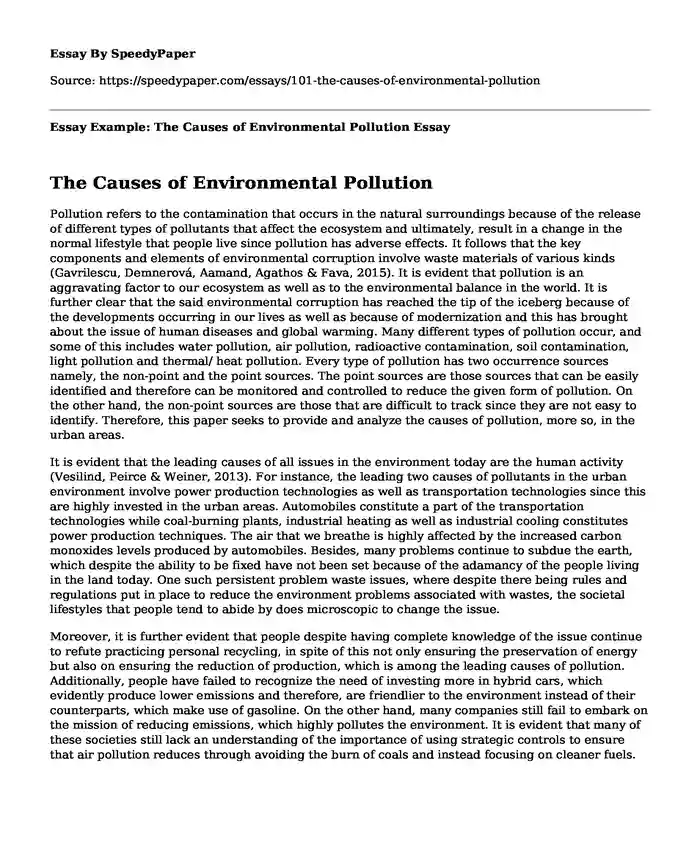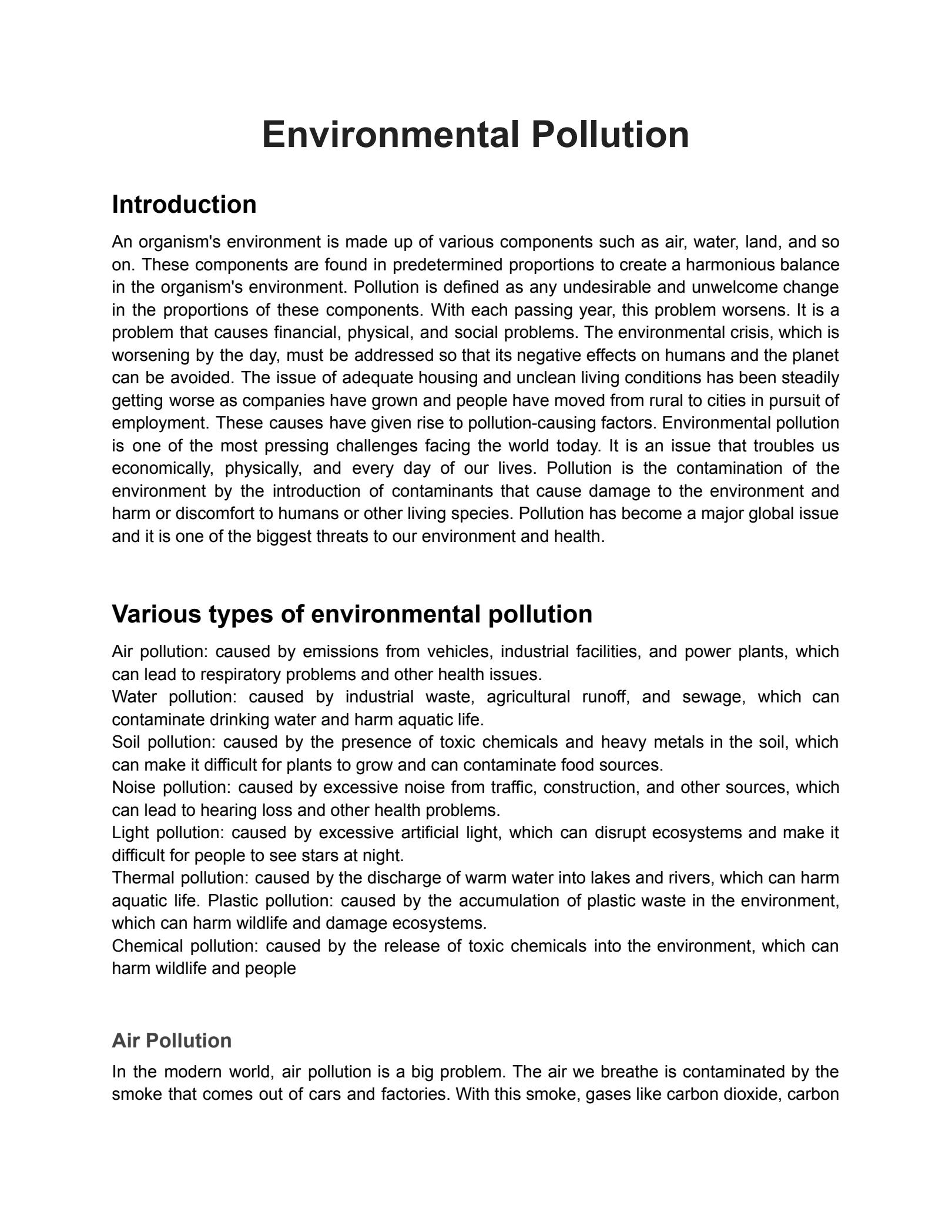Environment pollution composition includes air, water, and soil contamination due to human activities. It threatens ecosystems and public health.
Pollution levels are reaching critical points globally, demanding urgent action. The sources of pollution range from industrial emissions to vehicle exhaust and consumer waste. Understanding the composition of pollutants is crucial for developing effective solutions to combat environmental degradation. By recognizing the different types and sources of pollution, we can work towards implementing sustainable practices and policies that will protect our planet for future generations.
Addressing environment pollution composition is a complex challenge that requires collective efforts and innovative strategies to create a cleaner and healthier world.
The Impact Of Pollution On The Environment
Air Pollution
Affects the atmosphere with harmful gases, causing health and environmental issues like smog.
Water Pollution
Contaminates water bodies with chemicals, trash, and toxins, harming aquatic life and human health.
Soil Pollution
Occurs when soil is contaminated by chemicals and waste, affecting plant growth and food safety.

Credit: www.facebook.com
Sources Of Pollution
Understanding the sources of pollution is crucial in addressing the environmental challenges we face. The composition of environmental pollution can be traced back to various human activities that release harmful substances into the air, water, and soil.
Industrial Activities
Industrial activities are major contributors to pollution, releasing pollutants such as chemicals, heavy metals, and greenhouse gases into the environment. Factories, manufacturing plants, and power plants emit toxic substances that degrade air and water quality.
Transportation
Transportation, including cars, trucks, and airplanes, also play a significant role in pollution. The burning of fossil fuels in engines leads to the release of carbon monoxide, nitrogen oxide, and particulate matter into the atmosphere, degrading air quality.
Agricultural Practices
Agricultural practices contribute to pollution through the use of pesticides, fertilizers, and animal waste. These substances can seep into the soil and water sources, leading to soil contamination and water pollution.
Consequences Of Environmental Pollution
Environmental pollution has severe consequences that impact our world. It poses grave threats to the ecosystem, causing air, water, and soil pollution. These pollutants greatly affect human health, biodiversity, and the balance of nature, necessitating urgent action for sustainable solutions.
Health Effects
Exposure to environmental pollution contributes to various health issues such as respiratory diseases, cardiovascular problems, and neurological disorders. Additionally, it increases the risk of cancer and negatively impacts the overall well-being of individuals living in polluted areas. The release of pollutants into the air, water, and soil poses a significant threat to public health.
Ecosystem Disruption
Environmental pollution disrupts ecosystems by leading to the loss of biodiversity, jeopardizing the survival of animal and plant species. Moreover, it contaminates habitats and affects the balance of ecosystems. For instance, water pollution can result in the destruction of aquatic life, leading to imbalances in food chains and the overall stability of ecosystems.
Climate Change Impacts
The pollution of the environment contributes to climate change by exacerbating existing issues such as global warming and altered weather patterns. This can result in extreme events, rising sea levels, and disruptive changes to natural systems. Furthermore, it impacts agricultural productivity and exacerbates natural disasters such as floods, droughts, and wildfires.
Measures To Control Pollution
Controlling pollution is crucial for the health and sustainability of our environment. The alarming levels of pollution worldwide have led to the implementation of various measures to mitigate its harmful effects. These measures primarily focus on regulations and policies, technological solutions, as well as public awareness and education.
Regulations And Policies
Government regulations and policies play a significant role in controlling pollution. These measures impose strict standards and guidelines that businesses and industries must adhere to in order to limit their environmental impact. They ensure that pollution-producing activities are carried out in a responsible and sustainable manner.
Some key regulations and policies include:
- Limits on emissions and discharges
- Prohibition of hazardous waste dumping
- Mandatory use of pollution control technologies
- Requirements for environmental impact assessments
- Imposition of fines and penalties for non-compliance
Technological Solutions
Technological advancements have played a crucial role in combating pollution. With the development of innovative solutions, industries are now able to minimize their impact on the environment. These technological solutions aim to reduce pollution emissions, promote energy efficiency, and enhance waste management.
Some notable technological solutions to control pollution include:
- Installation of pollution control devices, such as electrostatic precipitators and scrubbers, in industrial plants
- Adoption of cleaner and renewable energy sources, such as solar and wind power
- Implementation of advanced waste treatment and recycling facilities
- Use of efficient manufacturing processes to minimize resource consumption and waste generation
Public Awareness And Education
Creating awareness among the general public about the damaging effects of pollution is essential for its reduction. By educating individuals about the causes and consequences of pollution, they become aware of the actions they can take to minimize their own impact on the environment.
Public awareness and education programs focus on:
- Importance of recycling and waste reduction
- Benefits of using eco-friendly products
- Encouraging sustainable transportation methods, like carpooling and using public transportation
- Conserving energy by turning off lights and appliances when not in use
- Preserving natural resources and ecosystems
By promoting public participation and engagement, these initiatives empower individuals to contribute to pollution control efforts and foster a greener and more sustainable future.
Case Studies Of Pollution Mitigation
1. Kaikōura, New Zealand: From Coastal Pollution to Marine Conservation
Kaikōura, a picturesque coastal town in New Zealand, faced grave environmental challenges due to pollution from local industries, agriculture, and tourism. However, through dedicated efforts and collaboration, the community successfully mitigated pollution to revitalize their marine ecosystem.
By implementing strict waste management regulations, establishing marine reserves, and promoting sustainable tourism practices, Kaikōura witnessed a remarkable turnaround. Today, the town is a leading example of marine conservation, with thriving marine life, including whales, dolphins, and seals, attracting nature enthusiasts from around the world.
2. Curitiba, Brazil: Transforming Public Transportation to Reduce Air Pollution
Despite numerous success stories, the battle against pollution continues, and many cities still grapple with its detrimental effects. Some significant ongoing challenges include:
- Air Pollution in New Delhi, India: Despite various measures, New Delhi struggles with severe air pollution due to vehicular emissions, industrial activities, and agricultural burning. The government is actively working towards reducing pollution levels through policies that prioritize renewable energy, public transportation, and stricter emission standards for vehicles.
- Plastic Pollution in the Oceans: The pervasive issue of plastic pollution poses a continuous threat to marine life and ecosystems worldwide. It demands collective action to reduce single-use plastics, promote recycling, and implement innovative waste management systems.
- Industrial Pollution in China: Rapid industrialization has resulted in severe pollution challenges across China. The government strives to address this issue by imposing strict regulations, promoting clean technologies, and encouraging sustainable industrial practices.
Note that these are just a few examples, but pollution mitigation requires a concerted effort from individuals, communities, industries, and governments worldwide. By learning from success stories and acknowledging ongoing challenges, we can collectively work towards a cleaner and healthier environment for future generations.

Credit: www.youtube.com
The Role Of International Collaboration
The Role of International Collaboration in addressing environmental pollution is indispensable in today’s interconnected world. As environmental issues transcend national boundaries, it becomes crucial for countries to come together in a united effort to combat pollution and its detrimental effects on the planet. This collaboration involves a concerted effort to establish global agreements and implement cross-border initiatives that can effectively mitigate the impact of pollution on a multinational scale.
Global Agreements
Global agreements play a pivotal role in addressing environmental pollution as they provide a framework for nations to collectively tackle pressing environmental challenges. The establishment of international treaties and protocols, such as the Paris Agreement, sets the stage for coordinated action aimed at reducing greenhouse gas emissions, curbing deforestation, and promoting sustainable energy practices on a global scale. These agreements serve as a catalyst for shared responsibility and encourage nations to work in tandem towards a common goal, fostering a sense of global stewardship and accountability.
Cross-border Initiatives
Cross-border initiatives are instrumental in addressing the complex nature of environmental pollution that often transcends national borders. By fostering collaboration among neighboring countries and regions, these initiatives facilitate the exchange of best practices, technical expertise, and resources to address pollution hotspots and mitigate cross-border pollution impacts. Through coordinated efforts, such as joint research programs, information sharing, and collaborative environmental conservation projects, countries can collectively combat transboundary pollution and uphold the principles of environmental sustainability on a regional and international level.
Innovative Approaches To Pollution Reduction
Green Technologies
Green technologies focus on minimizing environmental impact.
- Solar panels convert sunlight into electricity.
- Wind turbines harness wind energy for power generation.
- Electric vehicles reduce carbon emissions from transportation.
Circular Economy Practices
Circular economy practices aim to reduce waste and promote sustainability.
- Recycling materials to create new products.
- Implementing product refurbishment and reuse programs.
- Optimizing resource efficiency in manufacturing processes.
The Future Of Environmental Pollution Management
As we progress towards a greener future, the management of environmental pollution becomes increasingly crucial. The future of environmental pollution management will be defined by innovative solutions and strategic planning that prioritize sustainability.
Emerging Trends
Renewable energy adoption is on the rise to reduce reliance on fossil fuels. Green infrastructure investments aim to improve air and water quality. Circular economy practices promote waste reduction and recycling.
Anticipated Challenges
Technological advancements require constant adaptation for effective pollution control. Global cooperation is needed for addressing transboundary pollution issues. Public awareness and education are essential for fostering a culture of environmental responsibility.

Credit: speedypaper.com
Frequently Asked Questions For Environment Pollution Composition
What Are The Main Causes Of Environmental Pollution?
Environmental pollution is primarily caused by industrial activities, vehicle emissions, improper waste disposal, deforestation, and use of non-renewable energy sources. These activities release harmful pollutants, such as greenhouse gases, chemicals, and particulate matter, into the air, water, and soil, leading to various environmental and health problems.
How Does Environmental Pollution Affect Human Health?
Environmental pollution can have severe impacts on human health. Exposure to air pollutants like fine particulate matter and toxins can cause respiratory issues, cardiovascular diseases, cancer, and other illnesses. Water pollution can lead to waterborne diseases, while soil pollution can contaminate crops and food, posing risks to human consumption.
What Are The Effects Of Environmental Pollution On Ecosystems?
Environmental pollution can disrupt ecosystems and harm wildlife. Air pollution can cause acid rain, affecting plant growth and aquatic life. Water pollution can deplete oxygen levels, leading to the death of fish and other aquatic organisms. Soil pollution can affect soil fertility and biodiversity, disrupting the delicate balance within ecosystems.
Conclusion
Environmental pollution poses a serious threat to the planet. Its impact on air, water, and soil quality requires urgent attention. By understanding the composition and sources of pollution, we can take effective steps to reduce and prevent its harmful effects.
Together, we can work towards a cleaner and healthier environment for future generations.







